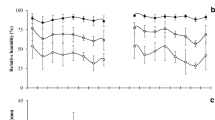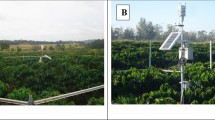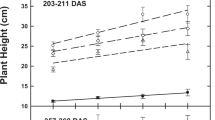Abstract
Despite the importance of coffee as a globally traded commodity and increasing concerns about risks associated with climate change, there is virtually no information about the effects of rising atmospheric [CO2] on field-grown coffee trees. This study shows the results of the first 2 years of an innovative experiment. Two commercial coffee cultivars (Catuaí and Obatã) were grown using the first free-air CO2 enrichment (FACE) facility in Latin America (ClimapestFACE). Plants of both cultivars maintained relatively high photosynthetic rates, water-use efficiency, increased growth and yield under elevated [CO2]. Harvestable crop yields increased 14.6 % for Catuaí and 12.0 % for Obatã. Leaf N content was lower in Obatã (5.2 %) grown under elevated [CO2] than under ambient [CO2]; N content was unresponsive to elevated [CO2] in Catuaí. Under elevated [CO2] reduced incidence of leaf miners (Leucoptera coffeella) occurred on both coffee cultivars during periods of high infestation. The percentage of leaves with parasitized and predated mines increased when leaf miner infestation was high, but there was no effect of elevated [CO2] on the incidence of natural enemies. The incidence of rust (Hemileia vastatrix) and Cercospora leaf spot (Cercospora coffeicola) was low during the trial, with maximum values of 5.8 and 1 %, respectively, and there was no significant effect of [CO2] treatments on disease incidence. The fungal community associated with mycotoxins was not affected by the treatments.




Similar content being viewed by others
References
Ainsworth EA, Long SP (2005) What have we learned from 15 years of free air CO2 enrichment (FACE)? A meta-analytic review of the responses of photosynthesis, canopy properties and plant production to rising CO2. New Phytol 165:351–372
Ainsworth EA, Rogers A (2007) The response of photosynthesis and stomatal conductance to rising [CO2]: mechanisms and environmental interactions. Plant Cell Environ 30:258–270
Batista D, Araújo WL, Antunes WC, Cavatte PC, Moraes GABK, Martins SCV, DaMatta FM (2012) Photosynthetic limitations in coffee plants are chiefly governed by diffusive factors. Trees 26:459–468
Chakraborty S, Datta S (2003) How will plant pathogens adapt to host plant resistance at elevated CO2 under a changing climate? New Pathol 159:733–742
Chalfoun SM, Chagas SJR, Pereira MC (1999) Determinação da microbiota associada a grãos beneficiados de café. Summa Phytopathol 25:369–372
DaMatta FM, Cunha RL, Antunes WC, Martins SVC, Araújo WL, Fernie AR, Moraes GABK (2008) In field-grown coffee trees source-sink manipulation alters photosynthetic rates, independently of carbon metabolism, via alterations in stomatal function. New Phytol 178:348–357
DaMatta FM, Grandis A, Arenque BC, Buckeridge MS (2010) Impacts of climate changes on crop physiology and food quality. Food Res Int 43:1814–1823
Davis AP, Gole TW, Baena S, Moat J (2012) The impact of climate change on indigenous arabica coffee (Coffea arabica): predicting future trends and identifying priorities. PLoS ONE 7, e47981
Fürstenberg-Hägg J, Zagrobelny M, Bak S (2013) Plant defense against insect herbivores. Int J Mol Sci 14:10242–10297
Gay C, Estrada CG, Conde C, Eakin H, Villers L (2006) Potential impacts of climate change on agriculture: a case of study of coffee production in Veracruz, Mexico. Clim Chang 79:259–288
Ghini R, Bettiol W, Hamada E (2011) Diseases in tropical and plantation crops as affected by climate changes: current knowledge and perspectives. Plant Pathol 60:122–132
Ghini R, Hamada E, Angelotti F, Costa LB, Bettiol W (2012) Research approaches, adaptation strategies, and knowledge gaps concerning the impacts of climate change on plant diseases. Trop Plant Pathol 37:5–24
IPCC (2013) Climate change 2013: the physical science basis. Cambridge University Press, Cambridge, United Kingdom and New York, NY, USA
Jaramillo J, Muchugu E, Vega FE, Davis A, Borgemeister C, Chabi-Olaye A (2011) Some like it hot: the influence and implications of climate change on coffee berry borer (Hypothenemus hampei) and coffee production in East Africa. PLoS ONE 6, e24528
Kutywayo D, Chemura A, Kusena W, Chidoko P, Mahoya C (2013) The impact of climate change on the potential distribution of agricultural pests: the case of the coffee white stem borer (Monochamus leuconotus P.) in Zimbabwe. PLoS ONE 8, e73432
Leakey ADB, Ainsworth EA, Bernacchi CJ, Rogers A, Long SP, Ort DR (2009) Elevated CO2 effects on plant carbon, nitrogen, and water relations: six important lessons from FACE. J Exp Bot 60:2859–2876
Long SP, Ainsworth EA, Leakey ADB, Ort D (2006) Food for thought: lower-than-expected crop yield stimulation with rising CO2 conditions. Science 312:1918–1921
Malavolta E, Vitti GC, de Oliveira AS (1997) Avaliação do estado nutricional das plantas: princípios e aplicações, 2nd edn. Potafos, Piracicaba
Martins LD, Tomaz MA, Lidon FC, DaMatta FM, Ramalho JC (2014a) Combined effects of elevated [CO2] and high temperature on leaf mineral balance in Coffea spp. plants. Clim Chang 126:365–379
Martins SVC, Galmés J, Cavatte PC, Pereira LF, Ventrella MC, DaMatta FM (2014b) Understanding the low photosynthetic rates of sun and shade coffee leaves: bridging the gap on the relative roles of hydraulic, diffusive and biochemical constraints to photosynthesis. PLoS ONE 9, e95571
Nogueira A, Martinez CA, Ferreira LL, Prado CHBA (2004) Photosynthesis and water use efficiency in twenty tropical tree species of differing succession status in a Brazilian reforestation. Photosynthetica 42:351–356
Parra JRP, Gonçalves W, Precetti AACM (1981) Flutuação populacional de parasitos e predadores de Perileucoptera coffeella (Guérin-Mèneville, 1842) em três localidades do Estado de São Paulo. Turrialba 31:357–364
Paterson RRM, Lima N, Taniwaki MH (2014) Coffee, mycotoxins and climate change. Food Res Int 61:1–15
Ramalho JC, Rodrigues AP, Semedo JN et al (2013) Sustained photosynthetic performance of Coffea spp. under long-term enhanced [CO2]. PLoS ONE 8, e82712
Santos CAF, Leitão AE, Pais IP, Lidon FC, Ramalho JC (2015) Perspectives on the potential impacts of climate changes on coffee plant and bean quality. Emir J Food Agric 27(2):152–163. doi:10.9755/ejfa.v27i2.19468
Silva CF, Schwan RF, Sousa Dias Ë, Wheals AE (2000) Microbial diversity during maturation and natural processing of coffee cherries of Coffea arabica in Brazil. Int J Food Microbiol 60:251–260
Silva EA, DaMatta FM, Ducatti C, Regazzi AJ, Barros RS (2004) Seasonal changes in vegetative growth and photosynthesis of arabica coffee trees. Field Crop Res 89:349–357
Vaughan MM, Huffaker A, Schmelz EA et al (2014) Effects of elevated [CO2] on maize defence against mycotoxigenic Fusarium verticillioides. Plant Cell Environ. doi:10.1111/pce.12337
Zullo J Jr, Pinto HS, Assad ED, de Ávila AMH (2011) Potential for growing arabica coffee in the extreme south of Brazil in a warmer world. Clim Chang 109:535–548
Acknowledgments
The authors are grateful to Embrapa (project 01.07.06.002.00: Climapest - Impacts of global climate changes on plant diseases, pests and weeds; and project 02.12.01.018.00: Impact of increased atmospheric carbon dioxide concentration and water availability on coffee agroecosystem under FACE facility] for financial support; Dr José R. P. Gonçalves (Embrapa Environment), in memoriam, for foliar N analysis; Dr Luiz Carlos Fazuoli and Dr Masako Toma Braghini (Instituto Agronômico de Campinas) for helpful comments and suggestions; technicians of Embrapa, especially Mr. Gilmar Victorino, for their contribution on FACE building and maintenance; for Conselho Nacional de Desenvolvimento Científico e Tecnológico (CNPq), Embrapa Coffee and Coordenação de Aperfeiçoamento de Pessoal de Nível Superior (CAPES) for research grants and scholarships.
Author information
Authors and Affiliations
Corresponding author
Electronic supplementary material
Below is the link to the electronic supplementary material.
Appendix 1
(DOCX 15 kb)
Appendix 2
(DOCX 18 kb)
Rights and permissions
About this article
Cite this article
Ghini, R., Torre-Neto, A., Dentzien, A.F.M. et al. Coffee growth, pest and yield responses to free-air CO2 enrichment. Climatic Change 132, 307–320 (2015). https://doi.org/10.1007/s10584-015-1422-2
Received:
Accepted:
Published:
Issue Date:
DOI: https://doi.org/10.1007/s10584-015-1422-2




